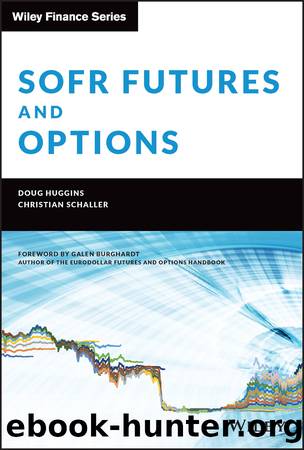SOFR Futures and Options by Christian Schaller & Christian Schaller

Author:Christian Schaller & Christian Schaller [Huggins, Doug & Schaller, Christian]
Language: eng
Format: epub
ISBN: 9781119888956
Publisher: Wiley
Published: 2022-09-14T00:00:00+00:00
CHAPTER 5
SOFR Future Options
The move from LIBOR to SOFR as reference rate implies a fundamentally new concept: Rather than using a term rate, we apply a daily rate. But SOFR futures combine the daily rates during their reference period into a (forward) term rate. Hence, when dealing with SOFR futures, the situation is similar to LIBOR; in a manner of speaking, one might say that SOFR futures transform the daily rates during their reference period into a term rate like LIBOR. And this is the reason behind the relatively easy transfer of concepts to the new reference rate. Via SOFR futures one does not need to deal directly with daily SOFR, but with the daily SOFR aggregated by the future.
However, once the SOFR futures contract enters its reference period, this aggregation ends and together with it the similarity to LIBOR and the direct transfer of concepts from the Eurodollar (ED) futures market. (Compare Figure 2.1.) As soon as the reference period starts, one needs to deal with daily SOFR values. When only the rate itself is concerned, this can be achieved by some straightforward adjustments for the front-month contract, discussed in Chapter 2 (e.g., for calculating the strip rate and executing the roll). But when volatility is also involved, the end of aggregation at the beginning of the reference period results in a completely new type of option. Before the reference period, options on SOFR futures have a forward term rate as underlying, as do options on ED contracts. But during the reference period, they depend on the path of daily SOFR values during the reference period. Thus, from one day to the next, at the start of the reference period, the same option on the same SOFR future, which used to behave like a standard American option on an ED futures contract, suddenly becomes an Asian option. In the manner of speaking used above, one might say that as SOFR futures enter their reference period, their aggregative function ends â and the options on them therefore transmogrify from standard options on a forward term rate to Asian options.
The fundamentally different concept of the new reference rate, whose practical consequences could be easily managed for futures, therefore manifests itself in a fundamentally different type of options on futures as soon as the reference period starts. From that point onward, one faces the mathematical challenge of pricing Asian options, which is further complicated by allowing jumps in the process. And both the markets using Asian options and the literature dealing with them have so far focused on Asian options of the European type only. Hence, the transfer from LIBOR to SOFR has resulted in a situation in which the options of the key money market (i.e., futures on the reference rate) are options without any pricing model available. From the perspective of options, the migration from LIBOR to SOFR can be considered as an uncontrolled1 experiment: By bureaucratic fiat, the huge market for options on the reference rate is transferred from
Download
This site does not store any files on its server. We only index and link to content provided by other sites. Please contact the content providers to delete copyright contents if any and email us, we'll remove relevant links or contents immediately.
| Analysis & Strategy | Bonds |
| Commodities | Derivatives |
| Futures | Introduction |
| Mutual Funds | Online Trading |
| Options | Portfolio Management |
| Real Estate | Stocks |
Rich Dad Poor Dad by Robert T. Kiyosaki(6414)
Pioneering Portfolio Management by David F. Swensen(6230)
How To Win Friends and Influence People by Dale Carnegie(4447)
The Money Culture by Michael Lewis(4083)
The Dhandho Investor by Mohnish Pabrai(3706)
The Wisdom of Finance by Mihir Desai(3659)
Liar's Poker by Michael Lewis(3372)
Fooled by Randomness: The Hidden Role of Chance in Life and in the Markets by Nassim Nicholas Taleb(3049)
The ONE Thing by Gary Keller(3013)
The Intelligent Investor by Benjamin Graham Jason Zweig(2996)
Mastering Bitcoin: Programming the Open Blockchain by Andreas M. Antonopoulos(2983)
Rich Dad Poor Dad: What The Rich Teach Their Kids About Money - That The Poor And Middle Class Do Not! by Robert T. Kiyosaki(2910)
How to Day Trade for a Living: Tools, Tactics, Money Management, Discipline and Trading Psychology by Andrew Aziz(2909)
Investing For Dummies by Eric Tyson(2895)
How to Win Friends and Influence People by Dale Carnegie(2864)
Market Wizards by Jack D. Schwager(2645)
The Psychology of Money by Morgan Housel(2634)
Zero Hour by Harry S. Dent Jr. & Andrew Pancholi(2614)
How to Pay Zero Taxes, 2018 by Jeff A. Schnepper(2604)
